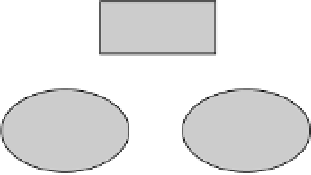Agriculture Reference
In-Depth Information
not solely due to disease build up, and some degen-
eration of clonal lines can be the result of deleterious
natural mutations.
Nevertheless, a primary problem in breeding clonal
crops is to keep parental lines and breeding stocks free
from viral and bacterial diseases that are transmitted
through vegetative propagation. Often it is necessary to
maintain disease-free breeding stocks that are separated
from those that are being tested for adaptation poten-
tial, as was the case with the potato breeding scheme
described above.
There
are
basically
two
methods
of
producing
apomictic cultivars.
Selfing a sexual clone to produce a segregating S
1
(due
to the clone being highly heterozygous). The progeny
can be screened for sexuals and apomicts. If apomicts
are obligate they have the potential of being a clonal
cultivar.
•
•
Crossing a sexual clone to an apomict clone to pro-
duce an 'F
1
' and selecting for sexual or apomicts
within the segregating population. Obligate apomicts
have the potential of being new cultivars.
Seed increase of clonal cultivars
The method is illustrated in Figure 4.10. Of course a
breeding scheme can use a combination of both meth-
ods of selfing and inter-crossing to develop a breeding
system. In many cases lines have been developed by
first selfing clones to achieve some degree of inbreeding,
which is aimed at reducing the frequency of deleterious
alleles, and then inter-crossing the partial inbred lines
to develop the apomict cultivar. The scheme shown in
Figure 4.10 also could begin by selfing a semi-apomictic
selection rather than a cross between an apomict and a
sexual parent.
Once the apomicts have been identified, the most
adapted lines are selected through repeated rounds of
evaluation over different environments and years.
One of the primary concerns associated with the
increase of new clonal cultivars is to prevent the stocks
becoming infected by viral or bacterial diseases during
commercial increase.
In vitro
methods can often help
in providing rapid increases of clonal stocks, which
can be easily kept disease-free. Such methods cannot
always be easily applied to many (particularly woody
plant types) species, where rates of multiplication
in
vitro
are often low and re-establishment under normal
field conditions is not always possible.
In vitro
multipli-
cation and applications for disease-free clonal material
are discussed later.
DEVELOPING APOMICTIC
CULTIVARS
Sexual
×
Apomictic
It is possible to develop clonal cultivars through obli-
gate apomixis (e.g. as with buffel grass). In species that
are grown from obligate apomictic seeds there tends
to be a positive relationship between the productivity
of a clone and its level of heterozygosity. It is there-
fore desirable to develop sources of genetic variability
to maximize productivity within the population and
this is a continual challenge to breeders of apomictic
crops. Essentially all the seed produced by an obligate
apomict are produced as a result of asexual reproduc-
tion. By far the most common means of producing
genetic variation and/or increasing heterozygosity, how-
ever, is by sexual reproduction or hybridization between
two chosen lines or populations. In developing apomic-
tic cultivars it is important that some seed can be
sexually produced so that this type of variation can be
exploited.
Self F
1
s
Self
sexuals
Apomictics
Select 'better'
obligate
apomictic
New cultivar
Figure 4.10
Breeding scheme for developing near
obligate apomict cultivars.
























